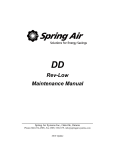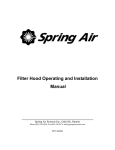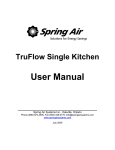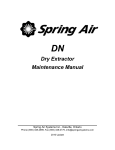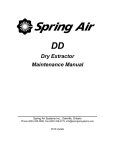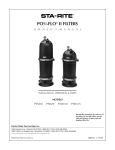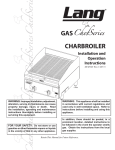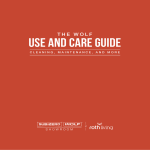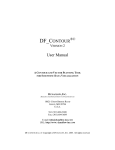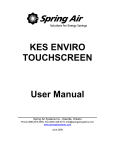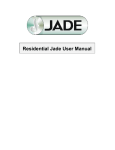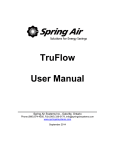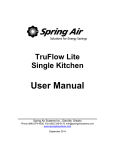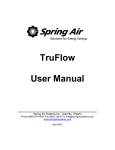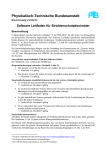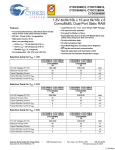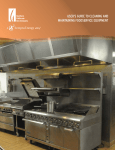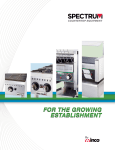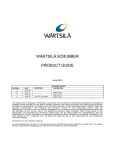Download KES Touchscreen User Manual 2009
Transcript
DN REVLOW Maintenance Manual ___________________________ Spring Air Systems Inc., Oakville, Ontario Phone (905) 338-2999, Fax (905) 338-0179, [email protected] 2010 Update DN REVLOW Maintenance and Operating Manual Table of Contents Introduction Spring Air Systems Hood Model Number Designations Principle of Operation Variflow Baffles Baffle Settings RevLow Maintenance Instructions Cleaning the Exterior Trouble Shooting Measuring the Exhaust Airflow Installing the Terminator Baffle Measuring the Supply Airflow – MB models only Measuring the Supply Airflow – MJ models only RevLow-Startup Report 1 1 2 3 3 4 5 5 6 7 8 10 11 INTRODUCTION Thank you for selecting a SPRING AIR SYSTEMS INC. Commercial kitchen exhaust RevLow dry extractor. Your system consists of a dry extractor, exhaust fan and on/off switch. Others may have supplied the exhaust fan and on/off operator. Your SPRING AIR SYSTEMS INC. Dry extractor model was selected to best meet the design requirements of your commercial kitchen application. The DN series dry ventilator is a UL/ULC listed “Exhaust Hood without Exhaust Fire Damper”. Typical SPRING AIR SYSTEMS Dry RevLow Ventilator Installation Figure 1 An ON/OFF selector switch located in the kitchen area or mounted on the exhaust fan starter coil electrical enclosure normally controls the exhaust fan. SPRING AIR SYSTEMS HOOD MODEL NUMBER DESIGNATIONS There are numerous types and styles of SPRING AIR SYSTEM RevLow ventilator available. Refer to the UL/ULC label for the complete model number and exhaust flow requirement for your dry ventilator. The UL/ULC label is located on the underside of the grease through on the right hand side of the dry ventilator. SPRING AIR SYSTEMS HOOD MODEL NUMBER DESIGNATIONS D D Dry Grease Extractor N D No exhaust fire damper Fusible link, dead weight fire damper B-F Box type rev-low hood MG MP MC MR Make up air through front grilles Make up air through perforated panels Make up air down discharge through perforated Make up air through rear wall plenum 10 4 The length of the ventilator in feet The width of the ventilator in feet N B-F MP 10 4 Model Number Designation – Ventilators Chart No1 DN-RevLow Maintenance and Operating Manual 1 PRINCIPLE OF OPERATION A commercial kitchen cooking line consists of many different appliances depending on the type of restaurant or institution. In every commercial kitchen the cooking vapors that comprise of grease, smoke, and products of Exhaust Air combustion rise off the cooking surface. Natural convection forces drive the cooking vapors up towards the back wall as shown in Roof of hood figure 2. The kitchen dilution air is entrained Core Extractor into the cooking vapors and the air mixture Variflow baffle generally follows the profile of the back and Back wall of hood top of the hood. The mixture of grease, Optional 3" aiir space Front of hood smoke, products of combustion, lint, dirt and kitchen dilution air proceed along the roof of the hood and follow a path down towards the Kitchen dilution air core extractor slot (the core extractor slot extends along the length of the hood). Most of Vapours from appliances the air mixture enters the slot and a small amount rolls back into the hood canopy to meet the main air stream again. APPLIANCES The RevLow Hood Model DN-B-F Figure 2 Optimizing the amount of air mixture that enters the core extractor slot is the key to the RevLow system. The RevLow hood must incrementally maximize the amount of the air mixture that enters the slot and minimize the amount of roll back into the canopy as the total amount of the air mixture deviates along the length of the cooking lineup. Exhaust duct collar Top of core extractor End mullion Front of core extractor Variflow Baffle Shown in full open position Core extractor slot Removable Inserts Grease trough Core extractor slot Section View of Core Extractor for DN-B-F RevLow Hood Figure 3 The RevLow accomplishes this complicated process with a unique core extractor profile that contains a series of specially designed Variflow baffles located along length of the core extractor. See Figure 3 above. The Variflow baffles are adjusted prior to shipment to allow the optimum amount of the air mixture to enter the core extractor slot and thereby minimize roll back into the hood canopy. For instance the Variflow baffles located above a Charbroiler are opened to the maximum 450 CFM/ft position and the Variflow baffles located above ovens or steamers are closed to the minimum 90 CFM/ft position. This variable adjustment along the length of each hood provides an exhaust system that truly minimizes the amount of exhaust air to properly ventilate any kitchen line up. DN-RevLow Maintenance and Operating Manual 2 Roof of hood Exhaust duct collar Core extractor Variflow Baffle Back W all Back of hood Front of hood Drain connection Baffle Closed Baffle Partially Closed Baffle Opened Section View of RevLow Extractor with Detail of Variflow Baffle Figure 4 BAFFLE SETTINGS Variflow Baffle labeling Figure 5 Each baffle is factory set based on the type of appliance under the hood. DN-RevLow Maintenance and Operating Manual 3 REVLOW MAINTENANCE INSTRUCTIONS Hood with Spring Air Systems RPD Controller {TruFlow Control Panel} At the start of the day 1. Rotate the occupied/Unoccupied switch to the occupied position to start the exhaust system {Touch the fan on/off icon on the Power window if system is not setup on automatic start/stop schedule}. The exhaust fan(s) will turn on and after a minute time delay the supply unit(s) will turn on. 2. Check each hood for air movement in the slot. Put your hand up to the entrance of the slot and feel if there is air movement. The air movement should feel the strongest over the heavy appliances. (broilers) Check Air Flow in slot 3. If there is no air movement check if the green fan light on the Spring Air remote panel is on (If not check the breaker panel or fuse), check if the motor starters have pulled in (Press the red reset button), and finally check fan belts in exhaust fan(s) on the roof. {TruFlow systems – check Operation Status window for messages}. If necessary, call a service technician. 4. Go to the makeup air diffusers and check for air movement from the supply unit. If no air movement check, motor starter (push red reset button), check fan belts on unit on roof. {TruFlow systems – check Operation Status window for messages}. If necessary, call a service technician. 5. Check that all the grease inserts are in the hoods and installed properly. At the end of the day 1. After the cooking equipment has been turned off rotate the occupied/Unoccupied switch to the unoccupied position to shut off the exhaust system. {Touch the fan on/off icon on the Power window if system is not setup on automatic start/stop schedule} The exhaust and supply fan(s) will shut down. 2. The RevLow hood will deposit particulate on both the hood backwall and roof. Wipe down the stainless steel backwall above the appliances and the interior of the hood, including the back and roof. Use a recognized hood degreaser. Wipe down the underside of the grease trough. This is located directly above the cooks’ head. Wipe Interior of Hood Empty Grease Cup Steam Clean Interior At the end of every other cooking day 1. Empty the grease cups located under the grease trough. 2. Remove the grease inserts and wash in a dishwasher or pot sink. . Use a recognized hood degreaser and clean to bare metal. 3. Replace the insert in the hood. DN-RevLow Maintenance and Operating Manual 4 At the end of the cooking day every six months 1. After removing the grease inserts for cleaning check the position of the Variflow Baffles in the hood. The Variflow Baffles should be open over the heavy equipment and closed over the lighter equipment. (Baffles should be wide open over charbroilers and closed over ovens. 2. Steam clean the interior of the grease extractor 3. Go to the roof and check the condition of the exhaust fan and makeup air fan belts. Tighten or replace as necessary. 4. Replace the makeup air filters. (Filter replacement times will vary with location of the restaurant). Inspect Baffle Positions Check Baffle Setting CLEANING THE EXTERIOR Normal soil can be removed with a mild detergent and water mixture applied to a cloth. To remove baked on grease, apply a cleanser to a damp cloth or sponge and rub on the metal in the direction of the polishing lines. DO NOT RUB IN A CIRCULAR MOTION. Burnt deposits, which do not respond, can usually be removed by rubbing the surface with a SCOTCH-BRITE scouring pad of STAINLESS scouring pads. DO NOT USE ORDINARY STEEL WOOL. Heat tint can be removed by a vigorous scouring in the direction of the polish lines using a SCOTCH BRITE of STAINLESS scouring pad in conjunction with a powdered cleanser. TROUBLE SHOOTING Low air (i) (ii) (iii) (iv) (iv) Improper exhaust fan rotation. Broken or slipping belt. Exhaust ductwork inspection door open. Obstruction in the ductwork. Flow-flow baffle must be adjusted No Air (i) (ii) (iii) (iv) (v) (vi) Broken belt. Exhaust fan overload tripped. Exhaust fan disconnect open. Exhaust fan motor fuse blown. Fire damper closed. Check if baffles are upside down in extractor. DN-RevLow Maintenance and Operating Manual 5 MEASURING THE EXHAUST AIRFLOW The exhaust air is measured along the inlet slot of the ventilator. To ensure accurate results take a reading every foot along the length of the ventilator is recommended. VANAXIAL VELOMETER Hold the instrument perpendicular to the VORTEX BAFFLE and parallel to the throat (inlet slot) of the ventilator. Velometer should not exceed three inches in diameter. Take one measurement per insert. PITOT TUBE OR ANEMOMETER Hold the instrument perpendicular to the VORTEX BAFFLE and parallel to the throat (inlet slot) of the ventilator. Take three readings across the throat and average the results per insert. Calculating the Exhaust Air Calculate the average velocity across the inlet slot. Refer to the chart below for the corresponding CFM/ft (l/s/m). Ventilator Type DN-B-F/DN-DI DN-B-F/DN-DI DN-B-F/DN-DI DN-B-F/DN-DI DN-B-F/DN-DI DN-B-F/DN-DI DN-B-F/DN-DI DN-B-F/DN-DI DN-B-F/DN-DI DN-B-F/DN-DI Velocity Exhaust Air Volume Fpm m/s CFM/ft l/s/m 450 675 900 1125 1350 1575 1800 2000 2250 2450 2.3 3.4 4.6 5.7 6.9 8.0 9.2 10.2 11.5 12.5 100 150 200 250 300 350 400 450 500 550 140 210 275 340 410 480 550 620 690 755 DN-RevLow Maintenance and Operating Manual 6 INSTALLING THE TERMINATOR BAFFLE The TBDD Terminator baffle is available in various lengths to suit adverse site conditions. This will provide additional exhaust air over heavy appliances that are being effected by the surrounding environment. Installation: Remove the TBDD from the packing material. Take off all of the Removable Access Doors “A” from the hood. You should be able to clearly see all the adjustable baffles “B” and their settings. Ensure that the adjustable baffle(s) “B” over the heavy appliance is set at 5, or 3 if the baffle is directly beneath the exhaust duct collar. The TBDD baffles “C” are going to be installed on the adjustable baffles “B” over the light appliances. To install the TBDD baffle “C” onto the adjustable baffle “B” simply line up the gap on the TBDD baffle “C” with the lower end of baffle “B”. Tap the TBBD along the length until it is snug on baffle “B”. If the fit is loose remove the TBBD baffle “C” and gently tap the gap with a hammer in the middle and at each end. Re-attach to baffle “B”. Install these baffles on the two adjustable baffles “B” located on the right or left side of the charbroiler (when looking from the front of the hood). DN-RevLow Maintenance and Operating Manual 7 MEASURING THE SUPPLY AIRFLOW - MB Measuring the total supply fan airflow through the Blade: _____1. Remove Blade front discharge perforated panel with appropriate tools. _____2. Turn Blade’s threaded rod counter-clockwise until the Blade comes to a fully open position, which is required to determine the total supply volume at each hood. _____3. Turn supply fan on. _____4. Re-install Blade front discharge perforated plate with appropriate tools. _____5. Take velocity reading across the perforated plate as shown in the diagram below. Take two vertical readings, one at 2” from the bottom of perforation and one at 4”. Repeat these horizontal readings every 12” along the hood. _____6. Total all readings and divide by the number of reading to determine the average velocity. _____7. Multiply the average velocity x 72 x length of perforated panel (in inches) to determine the total CFM per perforated panel. (It is critical to take the velocity readings 1” off the surface of the perforated panel to use this formula). _____8. If the total supply volume was not correct and Spring Air Systems provided the supply fan/unit then adjust the supply volume at the fan/unit or at field supplied balancing dampers. If the supply fan/unit was not provided by Spring Air Systems advise the general contractor to adjust the supply air volume and do not proceed unit the volume has been correct. The total supply volume required can be found on the Spring Air Systems shop drawings. DN-RevLow Maintenance and Operating Manual 8 Measuring supply airflow through the Custom Comfort Dial: _____1. Remove Blade front discharge perforated panel with appropriate tools. _____2. Turn Blade’s threaded rod clockwise until the blade is 1.5 inches off the vertical front surface of the hood. See diagram below. _____3. Set the velometer parallel to the bottom discharge with the face open perpendicular to the perforated screen where the air discharges and take a reading every 12” apart for the full length of the hood. See diagram below. _____4. Total all velocity readings and divide by the number of reading to determine the average velocity. _____5. Refer to Custom Comfort Dial Velocity Chart below. Based on the hood length and the temperature rating indicated on the UL/ULC plate determine the Custom Comfort Dial Velocity. _____6. If the measured average velocity is too high, turn the Blade threaded rod counterclockwise 5 times. Re-measure average velocity. Repeat until the measured velocity at Comfort Dial is correct. _____7. If the measured average velocity is too low, turn the Blade threaded rod clockwise 5 times. Re-measure average velocity. Repeat until the measured velocity of Custom Comfort Dial is correct. FN or FB Hood Custom Comfort Dial Velocity Chart APPLIANCES CCD VELOCITY (fpm) 0 9 - 14 6-9 4-6 Up to 4 Set point 500 500 550 550 SIDE FLOW Set point 450 450 450 450 0 9 - 14 6-9 4-6 Up to 4 450 450 450 450 400 400 450 450 TEMP. Heavy - Charbroiler Heavy - Charbroiler Heavy - Charbroiler Heavy - Charbroiler 600 F 0 600 F 0 600 F 0 600 F Medium Medium Medium Medium 400 F 0 400 F 0 400 F 0 400 F – Griddle, fryer – Griddle, fryer – Griddle, fryer – Griddle, fryer Hood Length (ft) FRONT DN-RevLow Maintenance and Operating Manual 9 MEASURING THE SUPPLY AIRFLOW - MJ The supply air is measured along the bottom inside discharge opening of the make up air plenum. To ensure accurate results take a reading every one foot along the length of the ventilator. Measure supply air flow through comfort dial: _____1. Ensure the MJ blowers are powered when the exhaust fan is activated. _____2. Locate the rheostat on the back of the MJ Blower which is on top of the MJ plenum. _____3. Turn the rheostat 120 degree clock-wise to activate the MJ blower. _____4. Set the velometer parallel to the bottom discharge with the face open perpendicular to the perforated screen where the air discharges and take a reading every 12” apart for the full length of the hood. The first reading should be one inch from the end and continue every twelve inches to the opposite end of the ventilator. _____5. Total all velocity readings and divide by the number of readings to determine the average velocity. _____6. Refer to Custom Comfort Dial Velocity Chart below. Based on the hood length and the hood temperature rating indicated on the UL/ULC plate determine the Custom Comfort Dial velocity on the chart. _____7. If the measured average velocity is not correct adjust the rheostat as follows: Rotate clockwise for lower or counterclockwise for higher velocity. Retake the velocity reading to confirm the recommended set point. FN or FB Hood Custom Comfort Dial Velocity Chart APPLIANCES CCD VELOCITY (fpm) 0 9 - 14 6-9 4-6 Up to 4 Set point 500 500 550 550 SIDE FLOW Set point 450 450 450 450 0 9 - 14 6-9 4-6 Up to 4 450 450 450 450 400 400 450 450 TEMP. Heavy - Charbroiler Heavy - Charbroiler Heavy - Charbroiler Heavy - Charbroiler 600 F 0 600 F 0 600 F 0 600 F Medium Medium Medium Medium 400 F 0 400 F 0 400 F 0 400 F – Griddle, fryer – Griddle, fryer – Griddle, fryer – Griddle, fryer Hood Length (ft) FRONT DN-RevLow Maintenance and Operating Manual 10 Sample RevLow Start Up Report General Information Job Name Date Customer Location Spring Air Service Exhaust Fan Model No. Manufacturer Up blast Discharge Exhaust Fan HP Exhaust Air Design (CFM) Supply Air Design (CFM) Ventilator mounting Height from finished floor to front of hood Make Up Air Systems yes Good no Fair Poor None Hood Item Model Width Baffle Size * Baffle No. Baffle Setting Left to Right 1 2 3 4 5 6 Total Exhaust Measured CFM Design Exhaust CFM Length No. of baffles Design CFM Velocity Reading (fpm) Calculated Exhaust Volume per Baffle (CFM) ** Length No. of baffles Design CFM Velocity Reading (fpm) Calculated Exhaust Volume per Baffle (CFM) ** Hood Item Model Width Baffle Size * Baffle No. Baffle Setting Left to Right 1 2 3 4 5 6 Total Exhaust Measured CFM Design Exhaust CFM DN-RevLow Maintenance and Operating Manual 11 Hood Item Model Width Baffle Size * Baffle No. Baffle Setting Left to Right 1 2 3 4 5 6 Total Exhaust Measured CFM Design Exhaust CFM Length No. of baffles Design CFM Velocity Reading (fpm) Calculated Exhaust Volume per Baffle (CFM) ** Length No. of baffles Design CFM Velocity Reading (fpm) Calculated Exhaust Volume per Baffle (CFM) ** Length No. of baffles Design CFM Velocity Reading (fpm) Calculated Exhaust Volume per Baffle (CFM) ** Hood Item Model Width Baffle Size * Baffle No. Baffle Setting Left to Right 1 2 3 4 5 6 Total Exhaust Measured CFM Design Exhaust CFM Hood Item Model Width Baffle Size * Baffle No. Baffle Setting Left to Right 1 2 3 4 5 6 Total Exhaust Measured CFM Design Exhaust CFM DN-RevLow Maintenance and Operating Manual 12 Other Fine Products From • • • • • • RevLow Hoods DynaFlow Hoods TruFlow Energy Management Systems UL/ULC Listed Pollution Control Systems Dry Extractor Hoods Catridge Hoods • • • • • • Filter Hoods Water Wash Ventilators Surface Fire Suppression Commercial Kitchen Exhaust Fans Commercial Kitchen Supply Units Utility Distribution Systems Phone: 866-874-4505, FAX: 905-338-0179 [email protected] www.springairsystems.com















